‘Beating the Odds: 36 hours of Art in Schiedam, Netherlands’ – Part 1 – An adventure by Einat Moglad
Please enjoy this two-part travel essay by EAS network curator, artist, and workshop leader Einat Moglad about her experience with the Bookmark Artists Collective and its ‘Magic Mirror’ exhibition, which led to her journey, aesthetic explorations and discoveries in Schiedam, NL.
Against All Odds
My short adventure in the Netherlands began during an online workshop with the onset of the turbulent year of 2020. With the world going in and out of lockdowns, I wanted to create an ecosystem for artists to enhance creativity and a place of gathering and community that would be most appropriate for the circumstances.
And so, the Bookmark workshop was born.
The workshop was quite successful in attracting talented artists from around the world and also showcasing a communal exhibition in magazines and on the EAS website as an online show: ‘Rhythm of the Blue Marble’. I honestly expected that after such a successful endeavor we would all go our separate ways. However, the group expressed its desire to continue meeting and continuing the communal creation process. This led to the formation of the Bookmark Artist Collective (BAC).
Our first project as a collective was targeting a theme of spirituality. We read articles, met with experts, and learned a lot from each other on our spiritual viewpoints in life. We planned to create a magazine that would showcase our artistic output that resulted from this process. After two years of challenging work, the Bookmark Arts Collective Magazine on spirituality ‘Inside Out’ was released by members: Maria De Gaetano as editor, Magdalena Zajac as designer, and myself as curator.
 BAC received an invitation to perform an exhibition at SodaFabriek in Schiedam, Netherlands in the fall of 2021. BAC met with Peter Van Velzen, owner of SodaFabriek, and finalized a plan to present the upcoming summer. I wasn’t sure how this would be done exactly, or how I could curate this show from afar. Thanks to the support of EAS, I was able to travel to the Netherlands and felt confident I would be able to create the show the way I felt it should be presented. It was very exciting to be able to present this project in such a unique space.
BAC received an invitation to perform an exhibition at SodaFabriek in Schiedam, Netherlands in the fall of 2021. BAC met with Peter Van Velzen, owner of SodaFabriek, and finalized a plan to present the upcoming summer. I wasn’t sure how this would be done exactly, or how I could curate this show from afar. Thanks to the support of EAS, I was able to travel to the Netherlands and felt confident I would be able to create the show the way I felt it should be presented. It was very exciting to be able to present this project in such a unique space.
The show preparation took place while the world was still reeling from the implications of covid shutdowns, but I was hopeful that everything would work out by the time the exhibition was due to begin. I had this tingling feeling that against all odds it was still going to happen.
Alas, as final preparations for my travels were being made, I was notified that I couldn’t go due to special Covid restrictions specific to the Netherlands. I was surprised and saddened. I felt that I was too optimistic in the end. There wasn’t much I could do but attempt and curate the show remotely. The exhibition ‘Magic Mirror’ was successfully set up even with the added complications of working remotely. After two years of arduous work, it was a bit sad for me to be so far away from the location of the show.
There was a sudden change of circumstances once the exhibition had already begun, and I suddenly had an opportunity to attend it. I hadn’t been able to completely curate the exhibition myself, but at least I would be able to experience it in person. I had to decide quickly. It was already the last days of the exhibition. I had my own obligations to take into consideration. Should I go? Would it matter at this point? Should I even bother at this point?
YES, of course, YES.
I still remember with a tingling sensation how against all odds it finally happened. I simply had to be there. It was now or never. No regrets! I made my plans within a single day (accommodations, flights) to at least see the show, and say hello and goodbye. This project that my heart was so invested in, I simply had to be there.
Schiedam, Art Has a Different Tempo
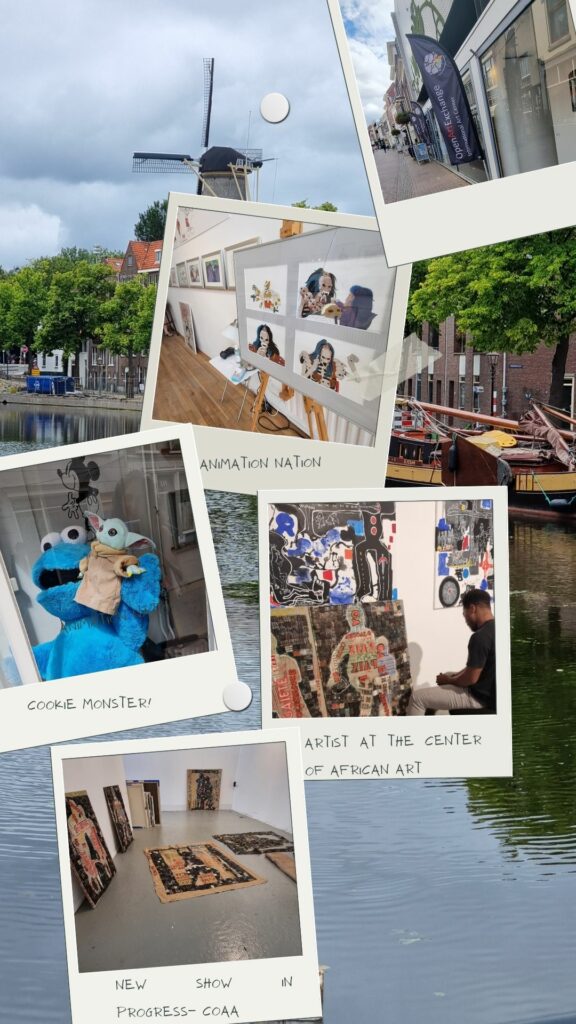 When I arrived in Schiedam at noon, my usual fast pace walks and temper suddenly seemed out of place and strange in this small town. My suitcase’s loud sound beating on the brick pavement seemed to violate the silent tranquility all around me. As I was crossing the canal, I realized that this town, much like its rivers, moves to the beat of the slow stream.
When I arrived in Schiedam at noon, my usual fast pace walks and temper suddenly seemed out of place and strange in this small town. My suitcase’s loud sound beating on the brick pavement seemed to violate the silent tranquility all around me. As I was crossing the canal, I realized that this town, much like its rivers, moves to the beat of the slow stream.
Skipping nervously from side to side, I was trying in vain to figure out the directions to my hotel. Suddenly, a local man noticed my “I’m Lost” vibes and truly went out of his way to help me and direct me to my destination. “Well,” I thought to myself, “this is not city life as I know it”. Although this was only going to be a short visit, it seemed that Schiedam was urging me to explore.
On my very first evening, I met with Art Stoop– artist, colleague, and a member of the BAC. Art showed me around the district, and we came across a gallery where we could see very interesting paintings being presented. As we thought about entering, we were greeted by the gallery owner, Jokka Bekker. She told us about the “Center for African Art” in Schiedam, a gallery and residency for African artists. It is strange seeing African art in the Netherlands, and I was curious about the circumstances that led Jokka to decide to support African art and artists.
Turns out that Jokka used to volunteer with Doctors Without Borders in Africa and came across too many African artists who had truly little chance of success in the international art world. She made this the gallery’s goal and mission statement--to be a voice and venue for these talented artists to have a real shot at being exposed to the art world of today. Jokka struck me as a pioneer and as a strong woman standing up for her beliefs and values. She felt that the process of art-making was just as important as the result. The gallery is organized to allow viewers who walk next to the gallery to see the artist in action and experience the magic that happens in the Center for African Art.
 The next day, I had scheduled to meet Peter van Velzen from SodaFabriek at the Stedelijk Museum in Schiedam. I arrived early, allowing me the opportunity to have a short stroll around the museum. As I walked down Hoogstraat Street, I suddenly saw a huge cookie monster chewing on a Yoda doll and some Disney illustrations. “Well,” I thought “this is an interesting place” and I decided to go in. I found myself in a gallery dedicated to sketches and animation art. I was greeted by Wolter, the founder of the Animation Nation Gallery.
The next day, I had scheduled to meet Peter van Velzen from SodaFabriek at the Stedelijk Museum in Schiedam. I arrived early, allowing me the opportunity to have a short stroll around the museum. As I walked down Hoogstraat Street, I suddenly saw a huge cookie monster chewing on a Yoda doll and some Disney illustrations. “Well,” I thought “this is an interesting place” and I decided to go in. I found myself in a gallery dedicated to sketches and animation art. I was greeted by Wolter, the founder of the Animation Nation Gallery.
Wolter worked for many years as an animation movies documentarist. His love and passion for animated movies seemed to be in his blood as he shared much of his knowledge about the process and the creation of animated films from past to present. Due to his work as a documentarist, he has gained access to many talented animation artists. Through these encounters, he was
able to procure a diverse collection of animation art: sketches, drawings and paintings.
Wolter’s collection holds plastic paintings that were traditionally used in animation. They are rare findings and highly coveted by collectors. I had a wonderful conversation with him and learned many new things about the art of animation that I didn’t know before. I felt as though I could spend hours talking with Wolter about animation but sadly the clock was ticking, and I needed to get to the Museum for my planned meeting with Peter.
I previously had many talks with Peter in preparing the exhibition at SodaFabriek via Zoom, but this would be my first time meeting him in person. Yet, we immediately recognized each other from a distance. It’s funny how the world of online meetings has made connections feel so real and natural even when stepping outside the digital sphere.
Stedelijk Museum - Art Is Religion
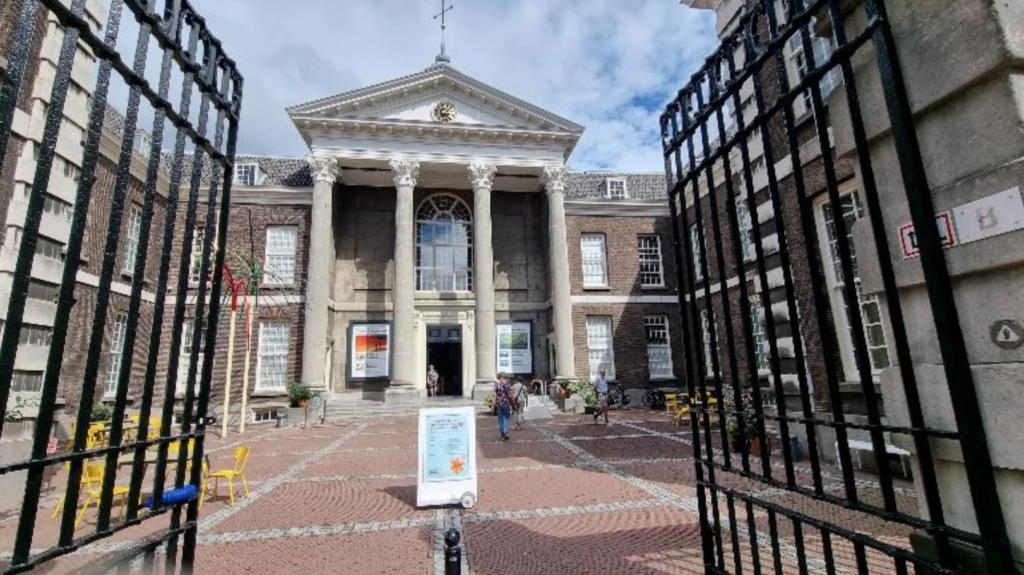 Peter and I entered the main hall of the museum which used to be an old church. We bought tickets under the pulpit. This combination of art and religion felt as though it said “This place is sacred” and I’m definitely one of its disciples. 😊
Peter and I entered the main hall of the museum which used to be an old church. We bought tickets under the pulpit. This combination of art and religion felt as though it said “This place is sacred” and I’m definitely one of its disciples. 😊
As we walked through the museum’s first exhibition, the history of Schiedam unfolded before me. Schiedam is a small city with a history of mainly working-class people. This was a chance for me to better understand the local culture and the creative ways residents found to sustain themselves.
 The museum offered several interesting exhibitions. The upper floors held a series of exhibitions dedicated to four elements: Water, Earth, Fire, and another quite surprising element. The ”Water” room was a blue room dedicated to the canals and to the movement and flow of water. “Fire” was a red room dedicated to dealing with fires and portraits of great disasters in Schiedam's past. “Earth” was a chance to see the local’s relation to agriculture and the earth itself. But…there was an interesting twist.
The museum offered several interesting exhibitions. The upper floors held a series of exhibitions dedicated to four elements: Water, Earth, Fire, and another quite surprising element. The ”Water” room was a blue room dedicated to the canals and to the movement and flow of water. “Fire” was a red room dedicated to dealing with fires and portraits of great disasters in Schiedam's past. “Earth” was a chance to see the local’s relation to agriculture and the earth itself. But…there was an interesting twist.
I expected the fourth room to be dedicated to wind with all those famous windmills decorating the Netherlands. However, the fourth element was actually “Technology”.
When I think about my encounters with Peter, transitioning so effortlessly from online to face-to-face, and how the very BAC endeavor was born in the online space, I can’t help but be thankful for the myriad ways technology can connect us.
Suddenly, it seems so natural that technology is indeed an element in our life, an element that surrounds and influences us. It allows us to experience this world in more dimensions and offers additional focused ways to experience our surroundings. This concept was beautifully presented in the wonderful installation by Muhcini Ennou – “Digital Landscape”.
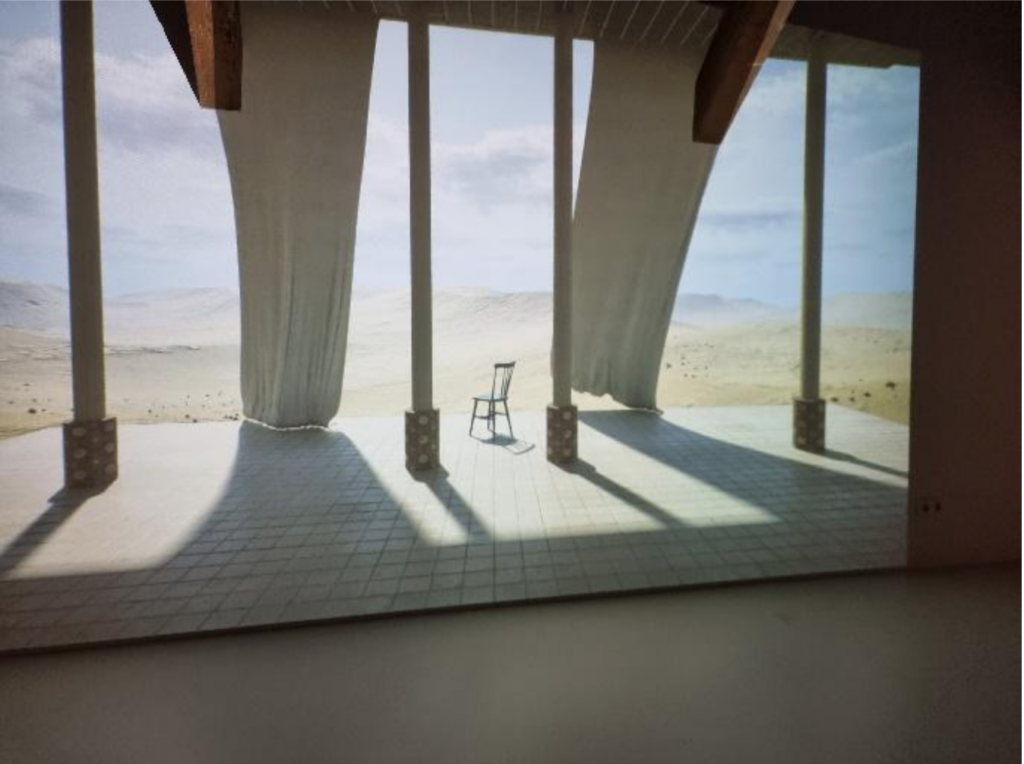 This work has its charm and a hypnotizing sensation due to its slow, meditative state. The space is filled with white curtains flowing in different corners of the room. In the middle, a video is being projected with many pillows around to sit comfortably in order to watch.
This work has its charm and a hypnotizing sensation due to its slow, meditative state. The space is filled with white curtains flowing in different corners of the room. In the middle, a video is being projected with many pillows around to sit comfortably in order to watch.
The video at its core is a simple presentation of a wide-open desert landscape. It’s been shot along the duration of a full day and night cycle, with white curtains flowing gently in the breeze. At first sight, it’s a simple video, but once I sat down to watch it I just couldn’t take my eyes off it. I could spend an entire day just watching the gentle movement of the curtains, entering a meditative state of peace and tranquility.
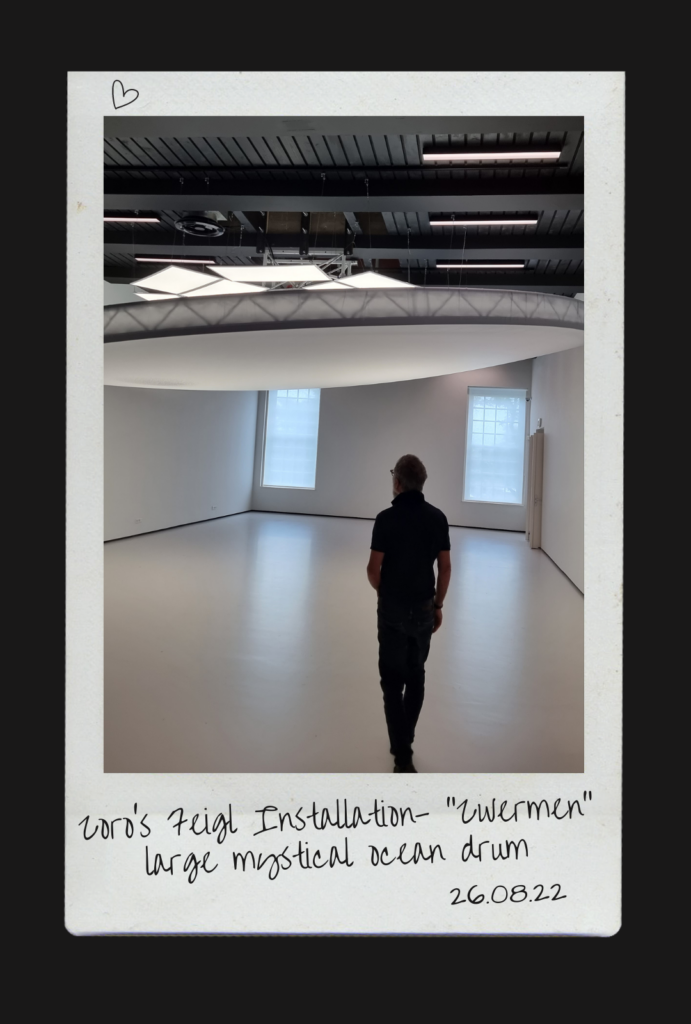 Another wonderful surprise was six large-scale installations by a team led by Zoro Feigl. As I was about to enter the first installation, I was profoundly impressed by Zoro placing a sign praising his team for the important help and effort they invested in the artworks being shown. This sign was a refreshing approach in the art world of single and mostly individualistic artists. As an artist striving to work within a collective, I believe that the impact of working together has qualities that aren’t well appreciated in today’s art world.
Another wonderful surprise was six large-scale installations by a team led by Zoro Feigl. As I was about to enter the first installation, I was profoundly impressed by Zoro placing a sign praising his team for the important help and effort they invested in the artworks being shown. This sign was a refreshing approach in the art world of single and mostly individualistic artists. As an artist striving to work within a collective, I believe that the impact of working together has qualities that aren’t well appreciated in today’s art world.
Zoro’s show presented a large-scale installation in the museum orchestrated by a gentle and subtle movement. These installations mimic nature in diverse ways and offer a whole-body experience.
One piece presented a loud, cold, man-made waterfall. It’s a very profound experience standing next to this orange waterfall with its cold air tingling in your nose and the water’s sensation wrapping you in during the warm summer day.
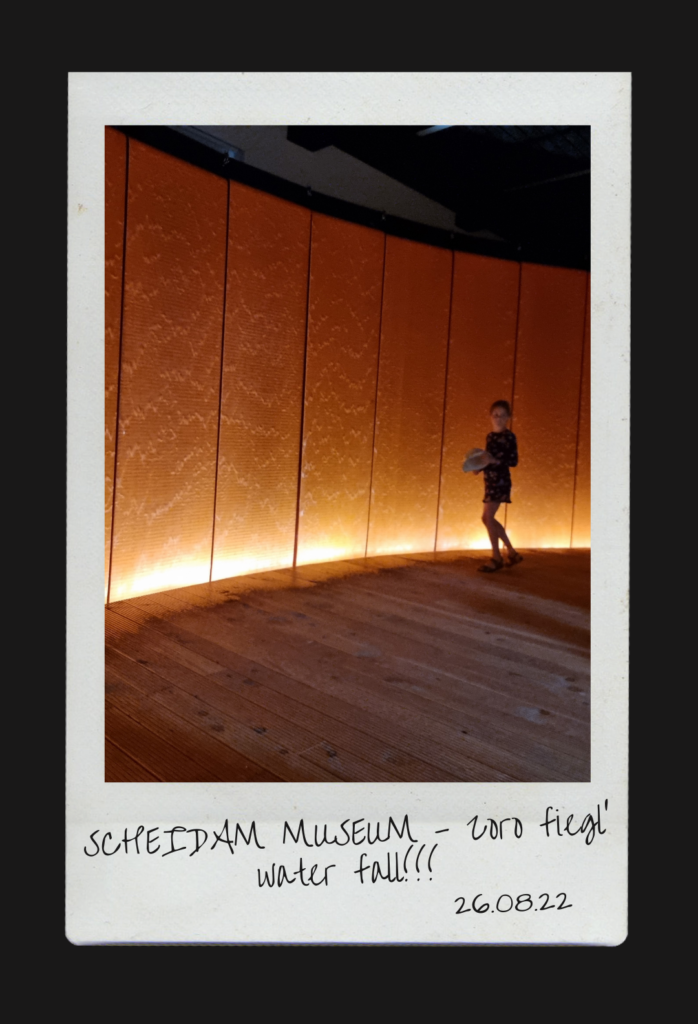 Zoro’s show offered many different installations where I had the chance to “fly on a magic carpet”, or sit by a water pond, or find myself standing below a large water drum echoing its soft marble crashing sounds.
Zoro’s show offered many different installations where I had the chance to “fly on a magic carpet”, or sit by a water pond, or find myself standing below a large water drum echoing its soft marble crashing sounds.
I felt the exhibition offered a spiritual sensation through my whole being and gave me a chance to not only be a passive observer but to interact with the piece and have some internal contemplation.
As the museum visit came to an end, I could honestly conclude that it was a truly delightful experience. It offered me a chance to feel that much like Schiedam’s rivers and canals, art can move to its own beat of a slow stream of beauty and awe.
Part 2 of this essay:
Traveling to the Soda Fabriek, a former gin factory transformed into a rustic creative space, and the Bookmark Art Collective's 'Magic Mirror' Exhibition.
